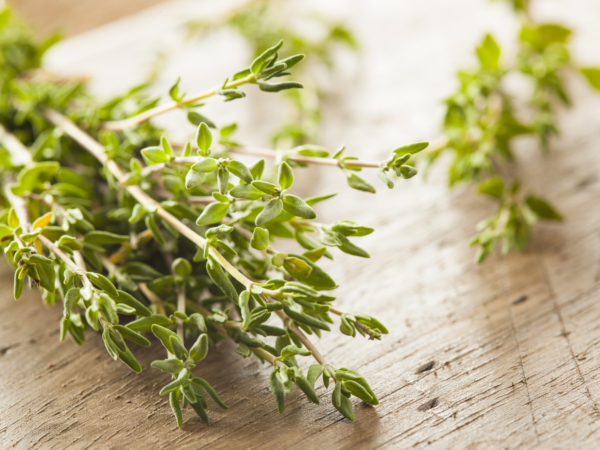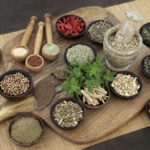Cooking With Spices: Thyme

Thyme (Thymus vulgaris) is a delicate perennial herb native to Asia, southern Europe and the Mediterranean region. It is distinctive both in its appearance – small elliptical leaves are gray-green on top, silvery whitish beneath – and its savory, “penetrating” taste that lends itself to a variety of dishes. There are about sixty kinds, including lemon and orange thyme, but French thyme is the most commonly used for cooking.
Throughout history thyme has been prized for its medicinal, culinary and aromatic properties: it was used by ancient Egyptians to preserve their deceased pharaohs and in ancient Greece it was burned as incense in sacred temples.
The health benefits of thyme include its antibacterial and antifungal properties, especially in regard to chest and respiratory concerns. In addition to respiratory issues, oral preparations have been used to alleviate sore throat, digestive disorders and to stimulate appetite. Topically, it has been used as an antiseptic mouthwash for cough and tonsillitis. In oil form it can act as an insect repellent.
Thyme has a variety of phytochemicals in the form of flavonoids and volatile oils that have potent antioxidant activity. Thymol – the primary volatile oil constituent of thyme – has been found to stabilize and protect cell membranes and other cellular structures in animal models. Animal studies showed an increase in the percentage of healthy fatty acids – specifically, DHA (docosahexaenoic acid) – in the brain, kidney, and heart cell membranes of rats after thyme was given as a dietary supplement.
Thyme also has a long history as a food preservative. Current research points towards thyme not only being effective at preventing contamination, but also at decontaminating foods that were previously infected with bacteria. Studies published in Food Microbiology found that essential oils of thyme could decontaminate lettuce that contained Shigella, an infectious organism. This makes thyme an excellent herb to add to uncooked foods such as salads and dressings, as it may help to ensure fresh produce is safe to eat.
Thyme is also nutrient-rich. It is an excellent source of iron, manganese and vitamin K, as well as being a very good source of calcium and fiber.
When buying thyme, the fresh herb has more flavor than its dried counterpart, but both are readily available. When looking for fresh thyme, make sure it has green-gray leaves and is free from spots or yellowing. Store it in the refrigerator wrapped in a damp paper towel for up to one week. Dried thyme will last up to six months in a tightly sealed container stored away from light and heat.
Thyme is versatile, and an excellent seasoning for soups, stews and stocks. Notably, it is part of the traditional French bouquet of herbs called “garni” that consists of thyme, parsley and bay leaves. It is a natural addition to pasta sauces, egg dishes, beans and in poaching liquids.
Dr. Weil’s take:
I make sure to have thyme on hand at all times. It pairs well with nearly all southern Italian dishes, especially those that simmer slowly over long periods including slow-cooked sauces, stocks and stews. Be sure to add thyme early in the cooking process to allow the flavors in its essential oils to develop properly. Thyme’s savory, slightly pungent, clove-like flavor make it a particular favorite of mine with sautéed mushrooms and roasted root vegetables.
More information and some tasty thyme recipes:










